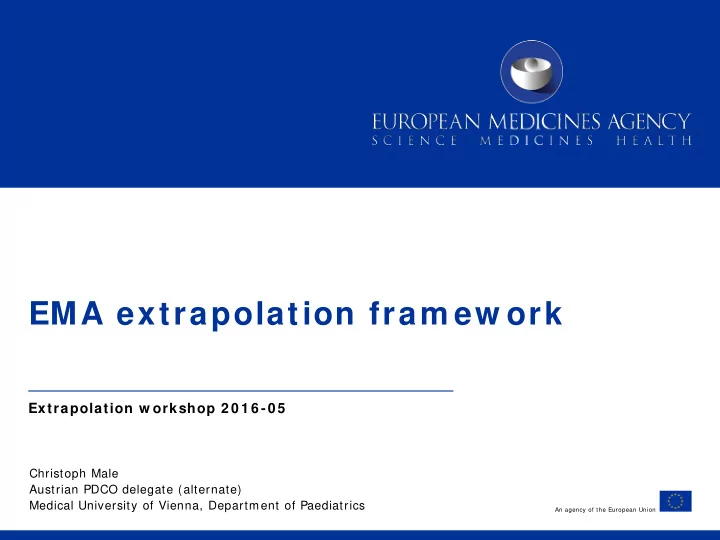

EMA extrapolation fram ew ork Extrapolation w orkshop 2 0 1 6 -0 5 Christoph Male Austrian PDCO delegate (alternate) Medical University of Vienna, Department of Paediatrics An agency of the European Union
Evidence base for medicine use in children Some paediatric data, practical experience Off-label Use Implicit extrapolation Reduced PIP based on expert judgement Adult data Intuitive extrapolation authorisatoin Paediatric Reduced PIP based on scientific rationale Explicit extrapolation Full paediatric development No extrapolation
Extrapolation definition Extending information and conclusions available from studies in one or more subgroups of the patient population (source population), … , to make inferences for another subgroup of the population (target population), … , thus minimizing the need to generate additional information ( types of studies, design modifications, n of patients required ) to reach conclusions for the target population,... EMA 2016, Reflection paper on extrapolation of efficacy and safety in paediatric medicine development
Rationale for extrapolation 1. To avoid ‚unnecessary‘ studies – if extrapolation from other sources is scientifically justified − ethics / ressource allocation / efficiency 2. Feasibility restrictions Apply extrapolation principles for rational interpretation of the limited evidence in the context of data available from other sources
Extrapolation Framework - To perform only necessary studies Rationale - Feasibility restrictions - Systematic synthesis of existing data to develop Extrapolation Concept quantitative predictions on PK/ PD, the disease, and clinical response in the target population - Studies required in target population to complete Extrapolation Plan the knowledge gaps. Reduced data requirements in accordance with predicted degree of similarities. - Use emerging data to confirm previous predictions Confirmation or, if needed adapt EP concept & plan - Interpretation of the limited data in the target Extrapolation population in the context of information extrapolated from the source population - Strategies to further confirm conclusions and Mitigate uncertainty & risk mitigate risks
Pharmacology Disease manifestation Clinical response to Drug disposition & effect & progression treatment SOURCE POULATION Age-related differences in Mechanisms Age-related differences in Age-related - ADME - aetiology - differences, - pathophysiology - applicability, - mode of action Adults - manifestation - validation - PD effects, E-R - Progression / indicators of efficacy & safety endpoints - Toxicity PB-PK/PD models Quantitative synthesis of Quantitative synthesis or meta- Quantitative evidence Pop-PK/PD models natural disease data analysis of treatment data Extrapolation concept Disease progression models Disease response models Covariates: Covariates: Covariates: - age, size, maturation, etc - age, maturation - age - disease, comorbidity, - disease types, severity - disease types, severity Children, paediatric age groups - comorbidity - comorbidity TARGET POPULATION existing data progressive input of emerging data Predict doses to achieve Describe/predict differences in Given similar drug exposure or - similar exposure, or natural course of disease PD response, predict degree of Prediction - similar PD effect, and progression differences in - acceptable safety - efficacy & safety - benefit-risk balance per age group by age group by age group refine predictions using emerging data
Extrapolation plan Proposed measures and studies in target population To complement the information extrapolated from source population(s) To confirm the extrapolation concept Pharmacology Disease Clinical response Extrapolation PK studies or Epidemiological data - Design of clinical studies plan PK/PD studies needed for - natural history data - Sample size(s) confirmation of doses - SOC treatment in target population in target population in target population to conclude on B/R balance
Extrapolation plan Reduction of data requirements in accordance with − predicted degree of similarities − strength of evidence (degree of uncertainties) No extrapolation : Data requirements • Full paediatric study programme Extrapolation: Extrapolation • Controlled E&S study with reduced sample size • Non-controlled ‚descriptive‘ E&S study • Dose-ranging study • PK or PK/PD study • etc.
Confirmation Use of emerging data to • Validate the modelling approaches used for extrapolation • Confirm the PK / PD model assumptions and predictions • Confirm the predicted degree of differences in disease progression and clinical response (efficacy, safety) Alternatively, revisit assumptions and adapt extrapolation concept and plan Iterative loops of prediction, data generation and confirmation, or adaption, when moving through the phases of development and into successive age subsets
Extrapolation Interpretation of the data generated in the target population in the context of information extrapolated from the source population (using models updated with the new data) Establish appropriate doses, exposures, PD response Conclude on efficacy and safety and benefit-risk balance in target population
Mitigating uncertainty and risk With increasing degree of extrapolation decreasing amount of data for validation ⇒ increasing risk of false conclusions Collateral criteria and measures: • Biological plausibility (in-vitro, preclinical and clinical data) • Iterative loops of model building and data generation • Concordant responses on different endpoints • Prospectively planned meta-analysis including future trials • Further validation by post-authorisation data • Validation of extrapolation approaches over several developments in related conditions, or related medicines
Many issues to be resolved … How to − weigh the strength of prior information? − quantify similarity of PK/PD, disease progression, clinical response? − quantify the uncertainty of extrapolation assumptions? − integrate expert judgement in the extrapolation concept? − link degree of similarity with reduction in data requirement − validate assumptions in the extrapolation concept? − interprete data in target and source population in conjunction? − deal with uncertainty and risk? − analyse and report post-authorisation data to support extrapolation?
How to quantify similarity?
Summary Key elements of extrapolation framework • Systematic and quantitative synthesis of existing data, using M&S, on the similarity between source and target population on several levels (PK/PD, disease progression, clinical response) • Quantitative (rather than qualitative) predictions on the degree of similarity in the target population • Reduction of the data required in the target population in accordance with the predicted degree of similarity • Iterative loops of prediction, data generation and confirmation, or adaption of the development plan, using M&S in planning & analysis • Continuing confirmation/re-evaluation in post-authorisation phase
Recommend
More recommend